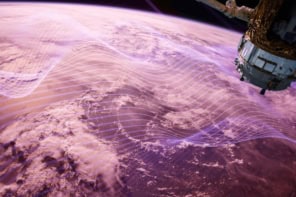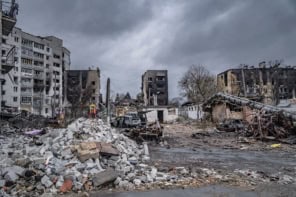On Earth Day’s 50th anniversary, Petteri Taalas – secretary-general of the World Meteorological Organization (WMO) – and Lars Peter Riishojgaard, who directs its Earth-system branch, talk to James Dacey about the WMO’s response to the global pandemic

Petteri Taalas, WMO secretary-general
Do you think the current – temporary – reduction of greenhouse-gas emissions and other human activities since the world went into lockdown following the COVID-19 outbreak can have a lasting impact on the environment and long-term climate trends?
There have been reported 6% reductions in carbon emissions and 40% reductions in atmospheric pollution, especially nitrous oxide emissions [over the last few months]. The pollution drop varies according to geographical location – polluted areas in China, India, Italy and France have seen short-term improvements following the drop of traffic and industrial activities. There was a phaseout of the previous continuous carbon-emission growth after the 2008 financial crisis, but thereafter the emission growth unfortunately continued. This is likely to happen once again when the COVID crisis is over, if no other efforts are made.
The COVID-19 pandemic has shown that fast and co-ordinated global action is possible in the face of emergency. What do you see as the main lessons that can be applied to tackling climate change?
As as optimist, I hope that the ability of mankind to join forces to act against a common enemy will be an asset while tackling the climate problem. One should keep in mind that both the economic and human wellbeing impacts of climate change would be an order of magnitude higher and would persist for hundreds of years, if we fail in climate mitigation.
It would be desirable to invest in climate-friendly industrial, energy and transport solutions while recovery investments are being made. In the best case this would speed up the crucially needed transition. The science community has shown – and will show – its power while tackling the COVID challenge. This may help in recovery of scientific authority after several post-truth years.
What is your key takeaway message on this 50th anniversary of Earth Day?
We are living on a unique and great planet. It is worthwhile to preserve it in good shape for the coming generations by tackling the climate change and population growth problems. Let’s make Earth great again!
Lars Peter Riishojgaard, director of the WMO’s Earth-system branch in the WMO’s infrastructure department
How does the WMO’s Global Observing System (GOS) feed into weather forecasting and climate modelling?

The observations provided by the WMO’s Global Observing System (GOS) provide the basis for any predictive modelling of weather and climate. Numerical weather prediction is what is mathematically called an initial value problem – the initial value comes from the observations, and without those no model predictions can be made. Fortunately most parts of the GOS continue to function despite the challenges of the pandemic, albeit at a reduced level for some components.
Many aspects of the GOS are automated, but what will be the major challenges if national lockdowns continue for months?
There are three major areas of impact. First, the observations provided by commercial aircraft are currently down to about 25% of normal in terms of volume. Second, we are already seeing substantial reductions in standard meteorological observations in those parts of the world where automation has not yet been widely adopted – locations in Africa, South and Central America. And third, there are challenges for the marine parts of the observing system: ships, floats, drifting and moored buoys. Most of these systems are automated, but planned repair, maintenance and resupply work is currently halted, and we are seeing a slow decline in observation numbers as a result.
Many nations in the world – particularly developing countries – were already facing challenges due to weather and climate-related hazards. In what ways does the COVID-19 pandemic exacerbate those challenges?
The impact of the COVID-19 crisis is likely to be asymmetric also in terms of its impact on weather and climate prediction. The biggest impact on the availability of observations is seen in the regions that were already the mostly poorly observed, notably Africa and the small island states everywhere on the globe. There is very little redundancy and resilience in the observing system in those areas. In terms of impact on specific weather situations, this will not be fully known until after the crisis is over and statistical studies can be done over a period of time.
With the reduction of meteorological data from commercial flights, the use of “radiosondes” has increased during the pandemic. What are these instruments and where are they being used?
Radiosondes are small instrument packages flown under balloons rising up through the atmosphere to altitudes of 20 to 30 km, transmitting measurements of wind speed, temperature and humidity back to the ground. These are flown all over the world twice per day. But over Europe, where few aircraft observations are currently available, some services have increased their radiosonde flights to four per day.

Life in a carbon-neutral world
How about space observations of Earth’s climate system – are the ground-based elements being affected?
The space-based systems are highly resilient to this particular type of crisis. Operational satellite systems, including their ground segments, are typically considered critical national assets. As such, they are planned, installed and staffed to ensure continued operation even in situations like the current one.



